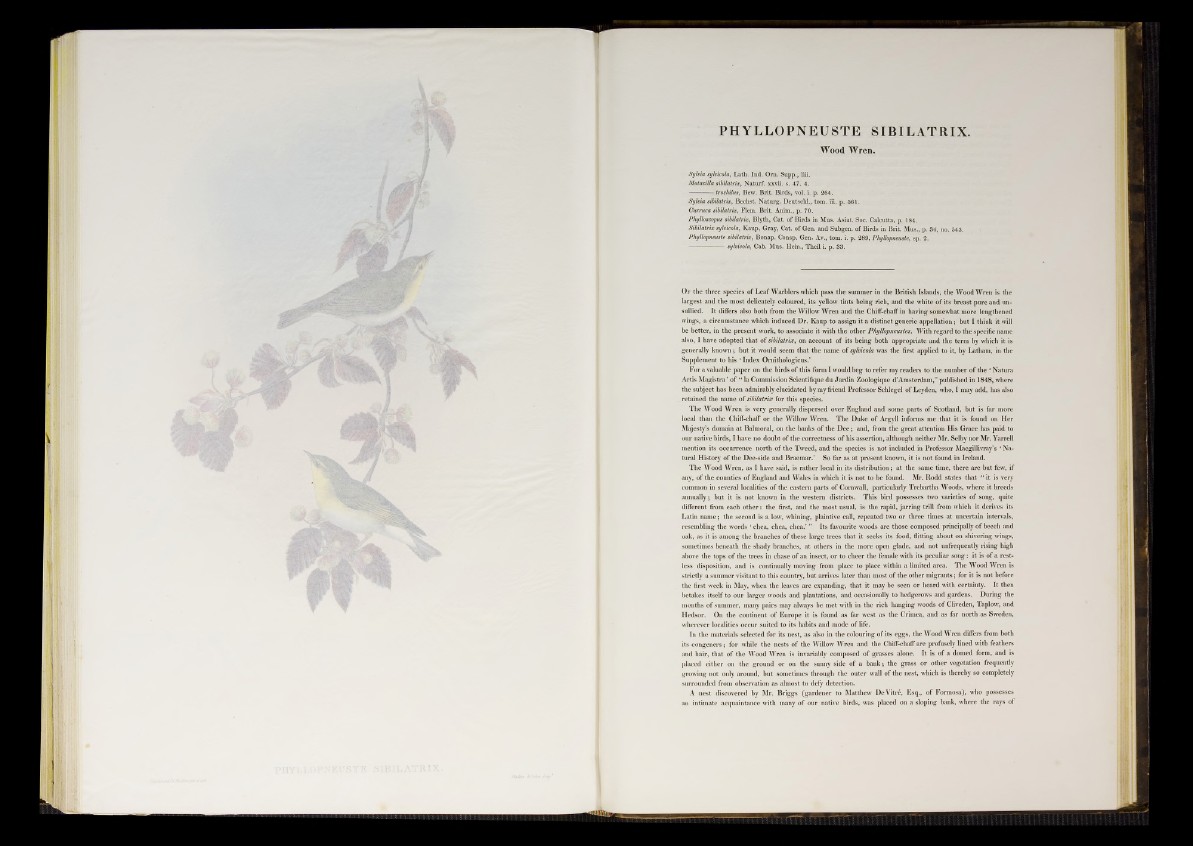
Wood Wren.
Sylvia sylvieola, Lath. Ind. Om. Supp., liii.
Motacilla sibilatrix, Naturf. xxvii. s. 47. 4.
----------- trochilus, Bew. Brit. Birds, vol. i. p. 264.
Sylvia sibilatrix, Bechst. Naturg. Deutschl., tom. iii. p. 561.
Curruca sibilatrix, Flem. Brit. Anim., p. 70.
Phylloscopus sibilatrix, Blyth, Cat. of Birds in Mus. Asiat. Soc. Calcutta, p. 184.
Sibilatrix sylvieola, Kaup, Gray, Cat. of Gen. and Subgen. of Birds in Brit. Mus., p. 34, no. 543.
Phyllopneuste sibilatrix, Bonap. Consp. Gen. Av., tom. i. p. 289, Phyllopneuste, sp. 2.
----------------sylvieola, Cab. Mus. Hein., Theil i. p. 33.
Of the three species of Leaf Warblers which pass the summer in the British Islands, the Wood Wren is the
largest and the most delicately coloured, its yellow tints being rich, and the white of its breast pure and unsullied.
It differs also both from the Willow Wren and the Chiff-chaff in having somewhat more lengthened
wings, a circumstance which induced Dr. Kaup to assign it a distinct generic appellation ; but I think it will
be better, in the present work, to associate it with the other Phyllopneustes. With regard to the specific name
also, I have adopted that of sibilatrix, on account of its being both appropriate and the term by which it is
generally known ; but it would seem that the name of sylvieola was the first applied to it, by Latham, in the
Supplement to his ‘ Index Omithologicus.’
For a valuable paper on the birds of this form I would beg to refer my readers to the number of the * Natura
Artis Magistra ’ of “ la Commission Scientifique du Jardin Zoologique d’Amsterdam,” published in 1848, where
the subject has been admirably elucidated by my friend Professor Schlegel of Leyden, who, I may add, has also
retained the name of sibilatrix for this species.
The Wood Wren is very generally dispersed over England and some parts of Scotland, but is far more
local than the Chiff-chaff or the Willow Wren. The Duke of Argyll informs me that it is found on Her
Majesty’s domain at Balmoral, on the banks of the Dee ; and, from the great attention His Grace has paid to
our native birds, I have no doubt of the correctness of his assertion, although neither Mr. Selby nor Mr. Yarrell
mention its occurrence north of the Tweed, and the species is not included in Professor Macgillivray’s I Natural
History of the Dee-side and Braemar.’ So far as at present known, it is not found in Ireland.
The Wood Wren, as I have said, is rather local in its distribution ; at the same time, there are but few, if
any, of the counties of England and Wales in which it is not to be found. Mr. Rodd states that “ it is very
common in several localities of the eastern parts of Cornwall, particularly Trebartha Woods, where it breeds
annually; but it is not known in the western districts. This bird possesses two varieties of song, quite
different from each other : the first, and the most usual, is the rapid, jarring trill from which it derives its
Latin name ; the second is a low, whining, plaintive call, repeated two or three times at uncertain intervals,
resembling the words ‘ chea, chea, chea.’ ” Its favourite woods are those composed principally of beech and
oak, as it is among the branches of these large trees that it seeks its food, flitting about on shivering wings,
sometimes beneath the shady branches, at others in the more open glade, and not unfrequently rising high
above the tops of the trees in chase of an insect, or to cheer the female with its peculiar song : it is of a restless
disposition, and is continually moving from place to place within a limited area. The Wood Wren is
strictly a summer visitant to this country, but arrives later than most of the other migrants ; for it is not before
the first week in May, when the leaves are expanding, that it may be seen or heard with certainty. It then
betakes itself to our larger woods and plantations, and occasionally to hedgerows and gardens. During the
months of summer, many pairs may always be met with in the rich hanging woods of Cliveden, Taplow, and
Hedsor. On the continent of Europe it is found as far west as the Crimea, and as far north as Sweden,
wherever localities occur suited to its habits and mode of life.
In the materials selected for its nest, as also in the colouring of its eggs, the Wood Wren differs from both
its congeners ; for while the nests of the Willow Wren and the Chiff-chaff are profusely lined with feathers
and hair, that of the Wood Wren is invariably composed of grasses alone. It is of a domed form, and is
placed either on the ground or on the sunny side of a bank; the grass or other vegetation frequently
growing not only around, but sometimes through the outer wall of the nest, which is thereby so completely
surrounded from observation as almost to defy detection.
A nest discovered by Mr. Briggs (gardener to Matthew De Vitré, Esq., of Formosa), who possesses
an intimate acquaintance with many of our native birds, was placed on a sloping bank, where the rays of